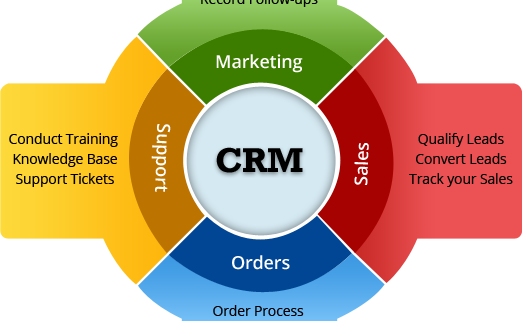CRM
Definition of CRM.

Customer relationship management (CRM) is a technology for managing all your company’s relationships and interactions with customers and potential customers. The goal is simple: Improve business relationships to grow your business. A CRM system helps companies stay connected to customers, streamline processes, and improve profitability.
When people talk about CRM, they are usually referring to a CRM system, a tool that helps with contact management, sales management, agent productivity, and more. CRM tools can now be used to manage customer relationships across the entire customer lifecycle, spanning marketing, sales, digital commerce, and customer service interactions.
CRM solution helps you focus on your organization’s relationships with individual people — including customers, service users, colleagues, or suppliers — throughout your lifecycle with them, including finding new customers, winning their business, and providing support and additional services throughout the relationship.
A CRM system gives everyone — from sales, customer service, business development, recruiting, marketing, or any other line of business — a better way to manage the external interactions and relationships that drive success. A CRM tool lets you store customer and prospect contact information, identify sales opportunities, record service issues, and manage marketing campaigns, all in one central location — and make information about every customer interaction available to anyone at your company who might need it.
With visibility and easy access to data, it’s easier to collaborate and increase productivity. Everyone in your company can see how customers have been communicated with, what they’ve bought, when they last purchased, what they paid, and so much more. CRM can help companies of all sizes drive business growth, and it can be especially beneficial to a small business, where teams often need to find ways to do more with less.
How a CRM system can help your business today.
1. CONNECT YOUR BUSINESS SILOS.
2. MAKE IMPROVEMENTS TO YOUR BOTTOM LINE.
3. IDENTIFY AND CATEGORIZE LEADS.
4. INCREASE CUSTOMER LIFETIME VALUE.
5. OFFER BETTER CUSTOMER SUPPORT.
6. IMPROVE PRODUCTS AND SERVICES.
7. BE READY FOR WHATEVER’S NEXT.
Here’s what cloud-based CRM offers your business.
CRM and the cloud computing revolution have changed everything. Perhaps the most significant recent development in CRM systems has been the move into the cloud from on-premises CRM software. Freed from the need to install software on tens, hundreds, or thousands of desktop computers and mobile devices, organizations worldwide are discovering the benefits of moving data, software, and services into a secure online environment.
WORK FROM ANYWHERE.
Cloud-based CRM systems such as Salesforce (Learn more: What is Salesforce?) mean every user has the same information, all the time. Your sales teams out on the road can check data, update it instantly after a meeting, or work from anywhere. The same information is available to anyone who needs it, from the sales team to the customer service representatives.
REDUCE COSTS.
CRM can be quick and easy to implement. A cloud-based system doesn’t need special installation, and there’s no hardware to set up, keeping IT costs low and removing the headache of version control and update schedules.
Generally, cloud-based CRM systems are priced on the number of users who access the system and the kinds of features needed. This can be very cost-effective in terms of capital outlay, and is also extremely flexible — enabling you to scale up and add more people as your business grows. Salesforce is flexible in terms of functionality, too — you’re not paying for any features that are not useful to you.
A CLOUD-BASED CRM PLATFORM OFFERS YOU:
Faster deployment
Automatic software updates
Cost-effectiveness and scalability
The ability to work from anywhere, on any device
Increased collaboration





Leave a Reply
Want to join the discussion?Feel free to contribute!